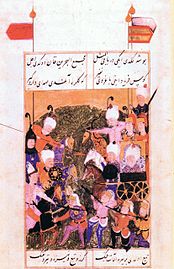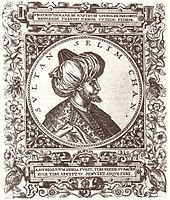Selim I.
Selim I (سليم شاه بن بايزيد / İA Selīm-şāh b. Bāyezīd ; * October 10, 1470 in Amasya ; † September 21, 1520 near Çorlu ), calledیاوز / Yavuz / 'the strict, the cruel, the grim', was the ninth sultan of the Ottoman Empire . He ruled from April 24, 1512 until his death in 1520. As the first Ottoman ruler, he held the title of caliph and guardian of the holy places (خادم الحرمين الشريفين, ḫādim al-ḥaramayn aš-Šarīfayn) .
Life
Selim was born around 1470 as the youngest of eight sons of the later sultan Bayezid II . His mother was probably the Dulkadir Princess Ayşe (also Gülbahar) Hatun, a daughter of Alaüddevle Bozkurt Bey . In 1487 Selim was sent as Prince Governor ( Çelebi Sulṭān ) to the strategically important coastal city of Trabzon , conquered by Mehmed II in 1461 , where he resided for over 20 years.
When Bayezid's sons intrigued against him because of his old age, he had Şehinşah and Mehmed strangled . He wanted to name his favorite son Ahmed as his successor, but he did not succeed in winning the Janissaries over to him. Rather, they demanded the more energetic Selim as ruler. He wanted to take the opportunity and overthrow his father. He moved into Rumelia in 1511 with allied Tatar troops and attacked his father's army near Uğraşdere in Thrace . Although Selim was beaten and fled to the Crimea , the Janissaries decided for him again. So he managed to beat his brother Ahmed and to be appointed commander in chief of the armed forces . On April 24, 1512, Bayezid II had to cede the throne to his son, who assumed the rule as Selim I. Bayezid withdrew to Dimotika , but died on May 26 under unknown circumstances on the trip.
Selim's first act as ruler was to order his brothers and all of his nephews to be executed . This fratricide had been institutionalized in the Osman house since Mehmed II. In order not to force his son Suleyman, later Sultan Suleyman I the Magnificent, to do so too, he renounced the conception of further sons. Nicolae Iorga writes:
- "[...] the Sultan did not want more heirs and renounced any further contact with his wives [...]"
As a devout Sunni , he persecuted the Alevis and Shiites in the Ottoman domain. The Shiite Iran under the Safavid shah Ismail I. supported the religionists persecuted massively. In the war that followed, on August 23, 1514, Selim defeated the Safavids in the decisive battle near Tschaldiran (also Çaldıran, in Eastern Anatolia ). Selim took the Safavid capital of Tabriz and brought many highly skilled craftsmen from there to Istanbul . Because the Janissaries were reluctant to fight Muslims and because of the onset of winter he broke off the campaign. Then he turned against the Mamluks ruling Egypt . In a large-scale campaign, after the Battle of Marj Dabiq near Haleb ( Aleppo ) in 1516, he first drove them out of Syria and Palestine , before defeating the Mamluk army at the Battle of Raydaniyya near Cairo and on January 22, 1517, the Egyptian capital conquer. The last Mamluk sultan, Tuman Bay , refused vassal status and was executed.
This ended the Mamluks' sole rule, but they remained the ruling class under the sultan's suzerainty. Selim quickly brought the rest of Egypt under his control. Shortly afterwards, almost the entire Arabian Peninsula submitted to his rule. Selim I thereby became ruler of the holy places of Islam, Mecca and Medina .
The last caliph of the Abbasid dynasty allegedly took his seat in Cairo after the conquest of Baghdad . Selim brought the incumbent caliph to Istanbul and his successors pleaded that he had transferred the caliphate to the Padishah. He is said to have given him the title and the associated insignia such as the sword and the cloak of the prophet. Since then, from a later Ottoman point of view, the Ottoman sultans were also the caliphs.
Now that a large part of the Islamic world was under Ottoman suzerainty, Selim began to prepare an expedition against Rhodes . But he fell ill and died in the ninth year of his reign at the age of 46, not far from the place where he had attacked his father's troops.
When Selim became Sultan, the Ottoman Empire covered an area of 2,375,000 square kilometers. Eight years later, the Ottoman Empire had an area of 6,557,000 square kilometers, 2.8 times the area. Selim's military successes were based on a reform of the Ottoman army . So he had the artillery ( Topçu ) modernized, contained the power of the Janissaries and began building a fleet . With his conquests in Asia and Africa, he gave his son Suleyman freedom of movement and thus laid the foundation for the Ottoman successes against the European powers in the subsequent Turkish wars .
Selim I is the founder of the Sultan Selim Mosque in Istanbul, but did not see its completion in 1522.
The chronicler İdris-i Bitlisî wrote the book Selimname about the reign of Selim I, but he could no longer complete the work. It was then completed by his son.
personality
Selim is described as a devout Muslim and an extremely ambitious ruler. He was seen as a soldier, ruthless daredevil, but also as clever and systematic. He is said to have started his four-month campaign against Persia against the advice of his ministers and had some of them executed because of their opposition to his plans. Alleged plans to conquer India and build the Suez Canal cannot be proven.
Selim wrote poems under the poet name Selimî mainly in Persian.
"A carpet has enough space for two Muslims, but the world does not have enough space for two rulers (kings, sultans)."
"My struggle continues until God's law, the Sharia , rules the whole world or I die."
The poet Revani wrote a collection of poems ( divan ) for Selim .
Namesake
Numerous squares and buildings were named after him, including the Yavuz Sultan Selim Mosque in Mannheim . The 3rd Bosphorus Bridge in Istanbul is also named after Selim I.
literature
- H. Erdem Çıpa: The Making of Selim: Succession, Legitimacy and Memory in the Early Modern Ottoman World . Indiana University Press, Bloomington (Indiana) 2017, ISBN 9780253024282 (English).
- Nicolae Iorga: History of the Ottoman Empire. Depicted according to the sources. 5 volumes, Verlag Perthes, Gotha 1908–1913, reprinted Frankfurt / Main 1990.
- Richard Franz Kreutel (translator): The pious Sultan Bayezid. The story of his reign [1481–1512] according to the old Ottoman chronicles of Oruç and Anonymus Hanivaldanus . (= Ottoman historians ; Volume 9). Verlag Styria, Graz / Vienna / Cologne 1978, ISBN 3-222-10469-7 .
- Ferenc Majoros, Bernd Rill: The Ottoman Empire 1300-1922. The story of a great power. Pustet, Regensburg / Styria, Graz 1994, ISBN 3-7917-1369-8
- K. Schwarz: Selim I. Yavuz . In: Biographical Lexicon on the History of Southeast Europe . Volume 4. Munich 1981, pp. 107-109
References and comments
- ↑ Miniature painted by Nakkaş Osman in the second half of the 16th century from the Şemāʾil-nāme Seyyid Lokman Çelebis. Including the Tughra of Selim I with unwoven writing: "Selīm-şāh, son of Bāyezīd Ḫān, who always victorious".
- ↑ The nicknameیاوز / Yavuz already wore Selim during his lifetime; see Mehmet İpşirli: Lakap. Osmanlılar'da Lakap. In: Türkiye Diyanet Vakfı İslâm Ansiklopedisi. Volume 27, TDV Yayını, Ankara 2003, p. 67.
- ↑ Josef Matuz: The Ottoman Empire. Baseline of its history. 6th edition. Primus Verlag, Darmstadt 2010, ISBN 978-3-89678-703-3 , p. 79.
- ^ Franz Babinger: Mehmed the Conqueror. World striker at a turning point. Piper Verlag, Munich 1987, ISBN 3-492-10621-8 , p. 60.
- ↑ Klaus Kreiser: The Ottoman State 1300-1922. 2nd Edition. R. Oldenbourg Verlag, Munich 2008, ISBN 978-3-486-58588-9 , p. 25.
- ↑ The exact year of birth is uncertain. 1467, 1468 and 1470 are mentioned.
- ↑ See Feridun M. Emecen: Yavuz Sultan Selim. Yitik Hazine Yayınları, Istanbul 2010, ISBN 978-9944-76-624-1 , p. 29.
- ↑ Feridun M. Emecen: Yavuz Sultan Selim. Yitik Hazine Yayınları, Istanbul 2010, ISBN 978-9944-76-624-1 , p. 32 ff.
- ^ Richard Franz Kreutel (translator): The pious Sultan Bayezid. The story of his reign [1481–1512] according to the old Ottoman chronicles of Oruç and Anonymus Hanivaldanus . In the series: Ottoman historians. Volume 9, Verlag Styria, Graz / Vienna / Cologne 1978, ISBN 3-222-10469-7 , pp. 15, 16, 212, 244 ff.
- ↑ a b Ferenc Majoros, Bernd Rill: The Ottoman Empire 1300-1922. The story of a great power. Weltbild Verlag GmbH, Augsburg 2000, Copyright by Friedrich Pustet Verlag, Regensburg, ISBN 3-8289-0336-3 , p. 209.
- ↑ Nicolae Iorga: History of the Ottoman Empire. Depicted according to the sources. Volume 2, Verlag Perthes, Gotha 1908–1913, reprinted Frankfurt / Main 1990.
- ↑ Ferenc Majoros / Bernd Rill: The Ottoman Empire 1300–1922. The story of a great power. Weltbild Verlag GmbH, Augsburg 2000, Copyright by Friedrich Pustet Verlag, Regensburg, ISBN 3-8289-0336-3 , pp. 210-212.
Web links
| predecessor | Office | successor |
|---|---|---|
| Bayezid II |
Sultan and Caliph of the Ottoman Empire 1512–1520 |
Suleyman I. |
| personal data | |
|---|---|
| SURNAME | Selim I. |
| ALTERNATIVE NAMES | Yavuz (the strict) |
| BRIEF DESCRIPTION | Sultan of the Ottoman Empire (1512–1520) |
| DATE OF BIRTH | around 1470 |
| PLACE OF BIRTH | Amasya |
| DATE OF DEATH | September 21, 1520 |
| Place of death | at Çorlu |






